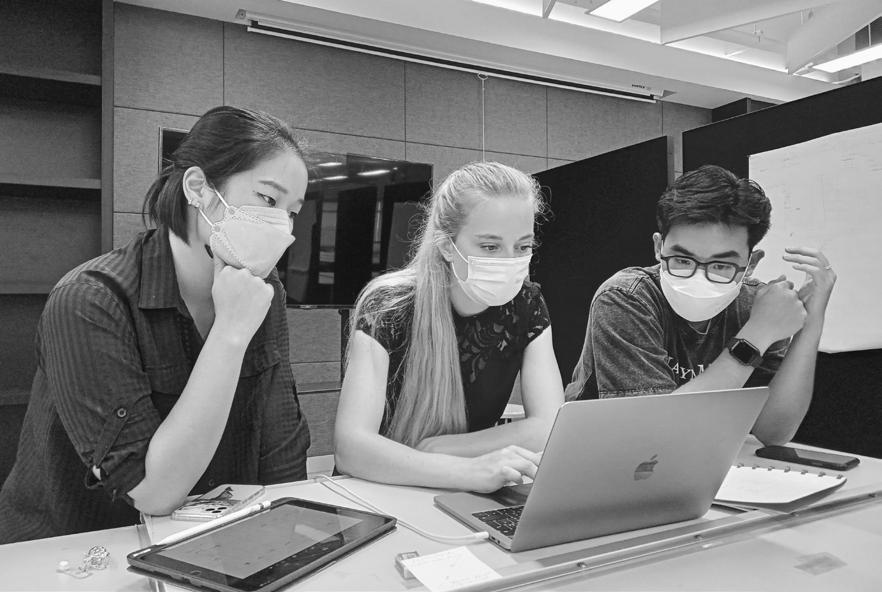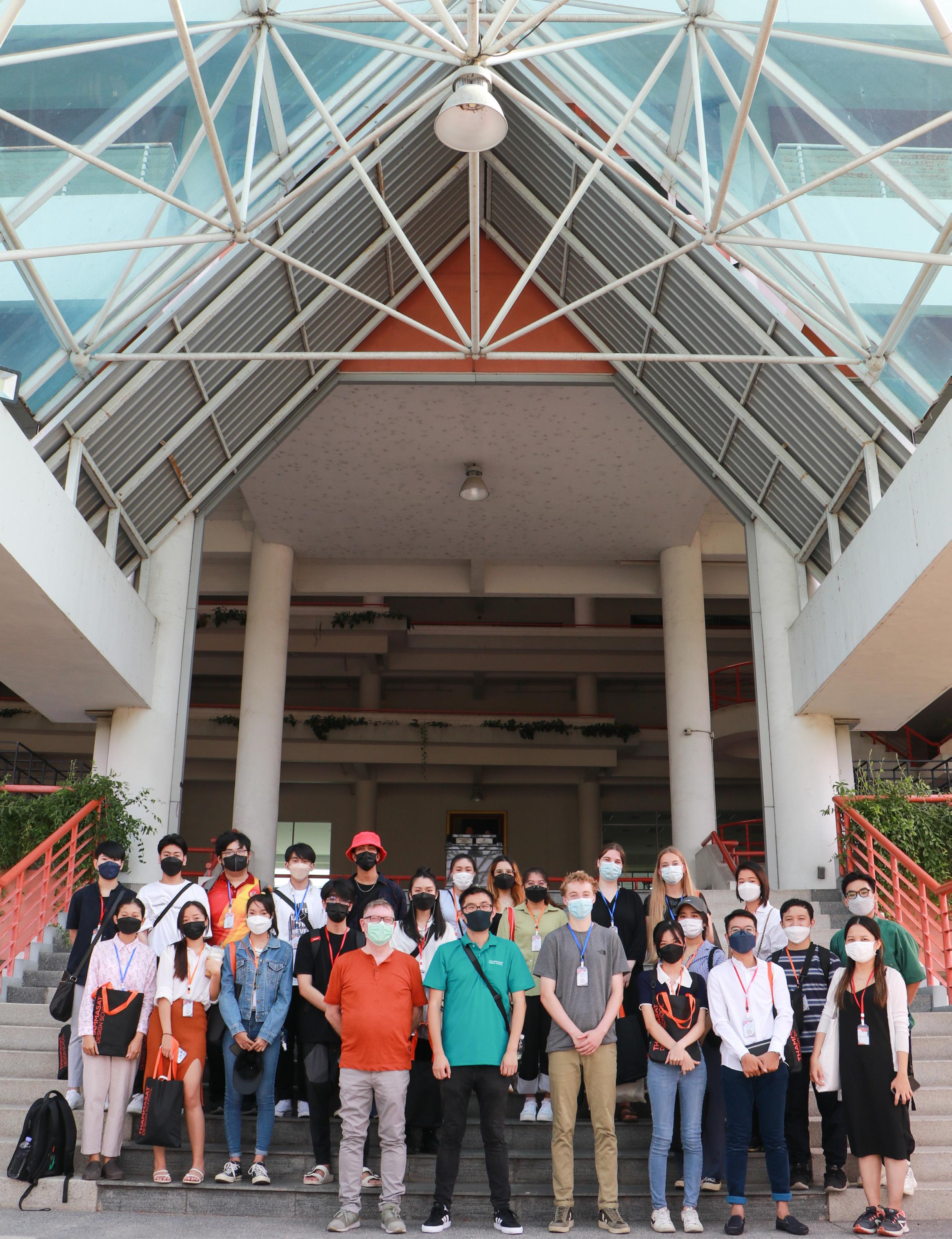
9 minute read
3.0 Workshop Activities
Opening Ceremony:
Associate Professor Gasinee Witoonchart, Rector of Thammasat University, officially opened the summer school. She welcomed the 23 Belgian, Burmese, Cambodian, Thai and Vietnamese participants from different backgrounds, encouraged both students and organizers in their endeavor and expressed her support for the cooperation with WHOTéchne.
Mr. Koenraad Du Pont, First Secretary of the Embassy of Belgium in Bangkok acknowledged the cooperation between Thammasat University and KU Leuven as a positive contribution to the academic relations between Thailand and Belgium and assured the organizers of his personal interest and the Embassy’s sustained involvement in academic diplomacy.
Dr. Richard Brown, Program Manager for Health Emergencies and Antimicrobial Resistance at the Thailand WHO Country Office, presented a background lecture on the ‘Impact of Infectious Diseases in Thailand and the SE Asia Region and WHO activities to reduce the risk of transmission’. He paid particular attention to the influence of vegetation, water bodies and natural ventilation in the built environment and pointed out the potential of these features towards the mitigation of infectious diseases.


1. Associate Professor Gasinee Witoonchart, Rector of Thammasat University 2. Mr. Koenraad Du Pont, First Secretary of the Embassy of Belgium 3. Dr. Richard Brown, Thailand WHO Country Office 1.
2.
3.
5.
6.
7.
Preparatory Stage
Understanding the medical, institutional and cultural background as well as visits to vernacular and contemporary best practices.




WHO-Téchne coordinator Mr. Michele Di Marco in his introductory lecture elaborated the core principles of the WHO document,’Roadmap to improve and ensure good indoor ventilation in the context of COVID-19’ which was a key reading and reference for the summer school workshop. Other preparatory activities included visits to vernacular examples (Agricultural Museum Complex in Pathum Thani; Jim Thompson House Museum) and contemporary cases (MQDC Forestia Project) of sustainable ecosystems. Subsequently, the participants visited the three project sites and decided on which site they would continue to work for the remainder of the summer school.
Dynamic Systems Analysis Stage
The first week of the program introduced a holistic way to handle complexity through systems thinking. The dynamic systems analysis coached the participants through successive phases of analysis from understanding the system and its driving forces towards a visual representation of their findings and the identification of highleverage interventions.
I. Framing Framing the System
In a first approach, participants tried to describe the system as it currently exists. They hypothesized current neighborhood parts and relationships in their physical, socio-economic and cultural dimensions. “Framing” also meant envisioning the future of the system by defining a long-term goal (aka. a “guiding star”) and a short-term objective (aka. a “provisional near star”) leading towards that goal.
4. Agricultural Museum Complex, Pathum Thani 5. Jim Thompson House Museum, Bangkok 6. Dr. Koen De Wandeler’s lecture 7. One of the students working on framing the system exercise
II. Sense-making and Analysis Listening to the System
“Listening” required a transdisciplinary exercise to understand the goals, perspectives, needs and drives of stakeholders. It involved reflections on the introductory lectures by Mr. Michele Di Marco, Dr. Richard Brown and Dr. Isaac Jamieson as well as site visits and discussions with residents. This enabled participants to verify their initial hypotheses against the local realities of each site, form teams according to their preferred site and to ascertain how stakeholders’ interactions and activities affected the system in that site.
Understanding the System
This process involved a series of exercises meant to explore how interactions and activities influence one another and to identify feedback loops.
Participants in each team started out by exploring, first individually and later in groups, the forces that were detrimental to the system ( “inhibitors”) as well as the forces that could generate positive dynamics in the system ( “enablers”). They clustered these forces into distinct themes which they gave a meaningful name and recorded their findings.
Next, they focused on the most influential forces and analyzed those to understand their respective causes and effects. They qualified whether the causes and effects had structural (i.e., linked to the physical and social environment), attitudinal (i.e., linked to beliefs and value systems) or transactional (i.e., linked to social processes and interactions) implications.
Zooming in on one of the factors that they considered important, the teams traced how these factors affected other factors and how these causes and effects fed into




8. Dr. Isaac Jamieson’s lecture 9. Understanding the system - Group 2, Bang Si Muang 10. Understanding the system - Group 3, Khlong Sam 11. Understanding the system - Group 1, Ari 9.
10.
11.

13.

14.

15.

12. Reframing - Group 2, Bang Si Muang 13. Systems mapping - Group 2, Bang Si Muang 14. Systems mapping - Group 3, Khlong Sam 15. Systems mapping - Group 1, Ari each other. They thus captured a series of causal patterns as dynamic loops which they qualified by determining whether these loops were making things worse, better, or kept things from getting better or worse.
III. Reframing
Envisioning Desired Futures Having analyzed the forces that influenced the system and the inner dynamics of causes and effects, participants moved from the current towards the desired future system. They did this by reexamining, first individually and later in groups, the identified loops and clustering them in thematic regions around a central loop that drove the system dynamics. They then generated a “systems map”, which is a holistic and cohesive visualization of those thematic regions, their interconnections and how they contribute to the central loop that drives the system dynamics. In parallel to the systems map they created a cohesive narrative that summarized the story of the systemsmap, its distinctive loops and the interconnections between the loops.
The mid-Summer-School Presentation gave each team an opportunity to test their understanding of the system by sharing their systems map and narrative with the other teams, the instructors as well as Anna Silenzi from WHO-Téchne. This exchange of approaches and insights helped each team to learn from each other and benefit from the feedback received.
Moreover, the newly acquired insights incited the participants of each team to refine their near and guiding starsthey had formulated in the beginning of the dynamic system analysis in function of the insights they had acquired in the process. This, in turn, led them to review their current understanding of the system and identify what patterns kept the current system from behaving according
to the short-term objective and the long-term goal they identified.
Building on the acquired knowledge of the system, teams recalibrated the systems map and highlighted those patterns that they would like to disrupt, mitigate or shift. They discussed the areas of leverage in the system that could have a large impact with a relatively small effort. Determining how each of the leverage points could impact the system they formed connections between short-term impacts over time and long-term systems change and articulated leverage hypotheses for each of the leverage areas they thought important.
Systemic Design Stage IV. Codesign
The second week of the program revolved around systemic design workshops that sought to articulate the leverage points that showed the most potential to improve the system. Students explored ideas for various interventions in terms of design strategies and beyond, ranging from lifestyle changes to policy recommendations. The design phase entailed the parallel production of a Systemic Matrix (matrix of prescriptive actions) and a Building Typology Design (descriptive schematic set of architectural drawings).




Lego Design Charette
On the first day of the codesign workshop, following an introductory lecture about designing with the environment by Dr. Adrian Lo, students engaged in the production of a Lego sectional model. This concept model enabled the groups to investigate a possible intervention at their chosen site, whilst considering solar orientation and angles, sun shading, cross ventilation, prevailing wind, and other aspects as discovered in their systems mappings. Following a guest lecture by Dr. Marianna Nigra on ‘Passive 16. Lego sectional model making - Group 2, Bang Si Muang 17. Dr. Adrian Lo’s lecture 18. Systemic collaborative codesign - Group 3, Khlong Sam 19. Lego sectional model making - Group 1, Ari 17.

18.
19.

21.

22. Design to Prevent Pandemic: The case study of a SARI Treatment Centre in Burkina Faso’, groups went back to revise their models, took photographs from which they produced an annotated sketch section.

Systemic Matrix + Building Typology Design
The remainder of the summer school saw the groups develop their ideas initiated from the Lego sectional model into a proposal for a building design along with a matrix of strategies. Each group in parallel with their Building Typology Design had to identify actionable items (leverage interventions) for the Systemic Matrix. Items were added and articulated to this matrix in correlation with their systems map and roadmap (strategization of leverage points towards a transitional / future system), strategies, and building design.
For the building design, each group had to identify detailed space requirements according to the specific needs of the site from which they had to develop a zoning diagram. This formed the basis to develop floorplans and sections, and a 3D digital model, all of which were collaboratively refined towards a final presentation.
23.

20. Lego sectional model making - Group 3, Khlong Sam 21. Lego sectional model presentation - Group 1, Ari 22. Systemic collaborative codesign - Group 2, Bang Si Muang 23. Systemic design peer review - Group 2, Bang Si Muang





